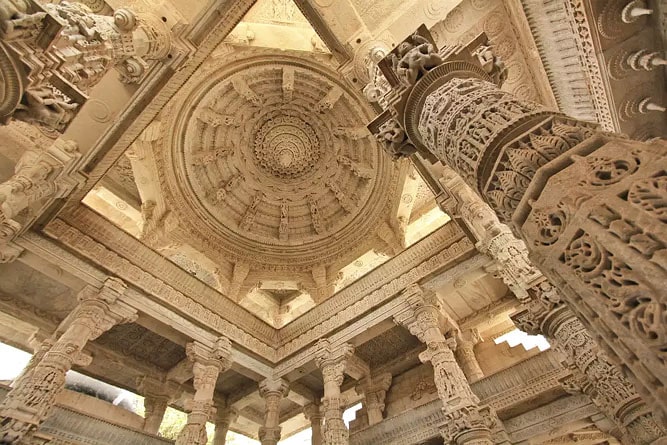Dilwara Temples
Jain temple at Mount Abu
should-see attraction
Opening hours: 12:00pm-6:00pm
Address: Delwara, Mount Abu, Rajasthan
Ticket price: Free
Visit duration: People typically spend 45 minutes to 1 hour here
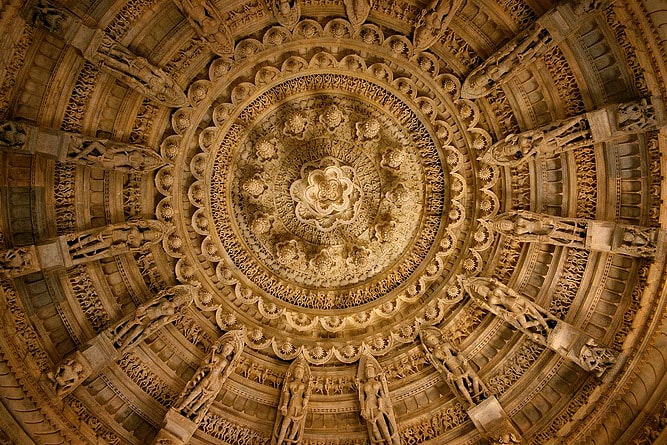
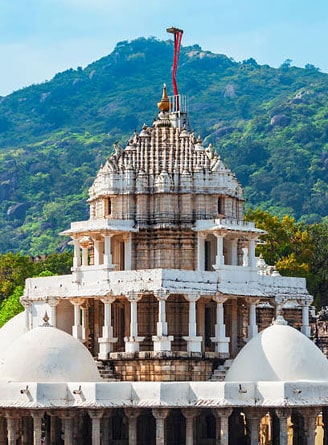
About the Dilwara Temples, Mount Abu
The Dilwara Temples, also known as Delvada Temples, are located at Sirohi in Rajasthan. This Svetambara Jain Temple is within three kilometres of Mount Abu. The rich cultural heritage of the land of Rajputs hosts a unique collection of edifices belonging to the Jain community.
The exterior of the temples offers a simple outlook but the aesthetic artwork of the interior of the temples reflects the marvellous architecture of the temple and the endeavours put forth by the workers. The temples existing beyond the inception of the town tell the tales of the bygone Jain architecture of Rajasthan.
History of the Dilwara Temples
The Dilwara Temples are dedicated to Adinath, the first Tirthankara, a Jain teacher. The temples were assembled between the 11th and 13th centuries by the Chalukya Dynasty. The temples are now handled by Seth Shri Kalyanji Anandji Pedhi, Sirohi.
The Adinatha or Vimala Vasahi Temple is dedicated to Lord Rishabha. The temple was mostly assembled in 1026 by Vimal Shah, a minister of Bhima I, the Chaulukya king of Gujarat whereas, Vastupala, a Jain-Gujarati minister of Dholka bore the expenses. Prithvipal, a descendant of Vimal Shah in 1147-49 constructed the Hastishala or the Elephant courtyard.
The Luna Vasahi or the Neminatha temple is dedicated to Lord Neminath. Two Porwad brothers, Vastupal and Tejpal, both were the ministers of a Virdhaval, the Vaghela ruler of Gujarat built the temple in 1230 of their late brother Lunig. The Kirti Stambh or the pillar of pride of the shrine was built by Maharana Kumbha of Mewar.
The Pittalhar Temple or the Adinatha temple is dedicated to the first Tirthankara, Rishabha Dev Adinath. Bhima Shah, a minister of Sultan Begada of Ahmedabad, a Gujarat dynasty 1316-1432 constructed the shrine.
Shri Parshav Nath Temple is a three-storied edifice that owns the tallest shrine among the Dilwara temples. The temple is made of grey sandstones. The exterior walls of the sanctum depict inscribed figurines of Dikpalas, Yakshinis, Vidhyadevis, and Shalabhanjikas.
Mahavir Swami Temple is dedicated to Lord Mahavira, the 24th Tirthankara. It was constructed in 1582.
Architecture of the Dilwara Temples
The Dilwara temples imitate the ‘Maru-Gurjara’ architecture. The temple is carved from pristine white marble and exhibits intricate engraved craftsmanship. The edifices took around 14 years to complete construction and employed around 1500 masons and 1200 labourers. The expense for the edifices went up to ₹185.3 million.
The Dilwara temples are isolated within the forest above 4000 feet in height and consist of five temples. The engraved patterns include arabesque patterns, lotus buds, petals, other floral designs and figurines of gods and goddesses in various dancing postures. The gateways, pillar ceilings and panels are decorated with detailed inscribed artworks reflecting the unique technique of the labours.
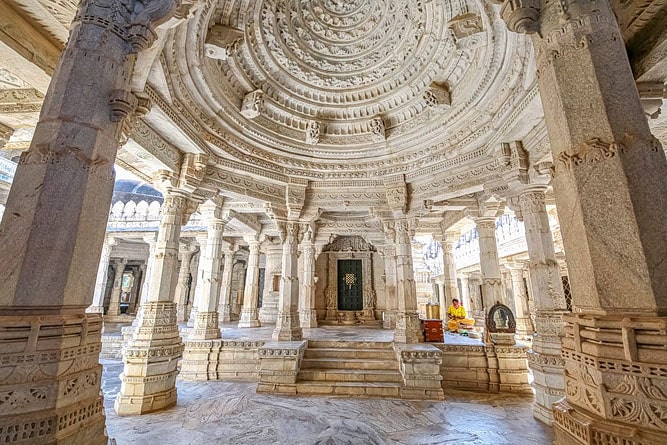
Vimal Vasahi Temple
The Adinatha or Vimala Vasahi Temple is carved out of white marble. The outer mandapa and 74 sub-shrines were a later addition. The temple has an open courtyard surrounded by carved corridors, pillars, arches, cells and 'mandaps', which contain smaller idols of the Tirthankaras.
The ceilings are engraved with lotus buds, petals, animal life and scenes from Jain mythology like the life journey, and the dream of the incarnation of Tirthankaras. The 59 Devakulikas, small shrines, face the principal image of Rishabhanatha. The cells house portraits of Ambaji, and Munisuvrata. The Mulnayak idol of Rishabhanatha is carved with attendant deities and images of 4 Tirthankar, naming the idol Saparikar Panchtirthi.
The Nav Chowki is a compilation of nine rectangular ceilings with ornamental carved pillars. The Gudh mandap, a simple hall in contrast to the heavily decorated entrance, houses two idols of Parshvanatha in the Kayotsarga position. The idol of Adi Nath or Lord Rishabdev also harbours in the mandap which is used for Aarti or worship of the deity. The ceiling is engraved with illustrations of sixteen goddesses, elephants, horses, dancers, musicians, and soldiers. The Hastishala or the Elephant courtyard illustrates a row of sculptures of elephants with the members of the family riding them.
Luna Vasahi Temple
The Luna Vasahi has a main hall or Rang mandap which features a central dome. A majestic ornamental pendant with elaborate carvings hangs from the dome. There are 72 figures of Tirthankaras in sitting posture and 360 small figures of Jain monks are designed in a winding format. There are a total of 47 sub-shrines and 130 pillars in the temple. The temple features noteworthy illustrative carvings depicting the life of Neminatha, Devkulikas, Chakreshvari and Lord Krishna as well.
The Navchowki showcases detailed marble stone cutting work and the Gudh mandap houses a black marble idol of the 22nd Tirthankara Neminatha. The Kirthi Stambha, a big black stone pillar, stands on the left side of the temple.
The first shrine houses an idol of the goddess Ambika while the ninth and eleventh portray Neminatha's life after renunciation and her marriage respectively. The fourteenth shrine displays the life events of Shantinatha and the thirty-seventh shrine has illustrations of four Goddesses. The Hathishala or elephant cell exhibits ten marble sculptures of elephants. The notable attraction is the carvings of the two niches of Derani and Jethani, the wives of Vastupal and Tejpal, which are seated with the image of goddess Lakshmi and sculptures of Sambhavanatha and Shantinatha respectively.
Pittalhar Temple
In the Pittalhar Temple, the massive statue of the first Tirthankara is built from five metals and brass which is called Pital in the Indian language and alludes to the name of the temple. The Shrine has 107 images and consists of the main Garbhagriha or the sanctum santorum, the Gudh mandap and the Navchowki with the idol of Yakshi Chakreshvari and Yaksha Gomukha on either side. The Gudh Mandap has a large marble Panch-Tirtha sculpture of Adinath. However, the construction of Rang Mandap and the corridor were left incomplete. In 1468-69, the old disfigured idol was substituted. According to the inscription, the weight of the new idol is 108 maunds, an ancient unit for mass which now equals four metric tons.
Parshwanath Temple
The temple contains four main halls with four majestic mandapas on the ground floor. The shrine holds a Chaumukha idol of Parshvanath.
The first floor houses the four iconography of Chintamani Parshvanath, Magalakar Parshvanath, and Manoratha- Kalpadruma Parshvnath along with nine cobras. However, the fourth picture is illegible. The corridor showcases paintings of 17 Tirthankaras and flowers. It also illustrates 14 dreams the mothers of Tirthankaras had before their births. The second floor has the idol of Sumatinatha, Parshvanatha, Adinatha, and Parshvanatha, and also the idol of Goddess Ambika. Finally, the third floor houses the idol of Parshvanatha. It is believed that leftover marble stones from Vimala Vasahi and Luna Vasahi were included in the grey stone temple by the masons.
Mahavir Swami Temple
The small Mahavir Swami temple has inscriptions prevailing on its walls. The veranda of the temple has paintings by artists of Sirohi, 1764. The intricate engraved illustrations comprise dancings figurines, court scenes, flowers, horse pigeons, and elephants. The altar of Mahavira has three idols of Tirthankaras settled on each side. Outside the temple is a rectangular marble slab with a triangle stone attached to the slab. The stone illustrates 133 miniature Tirthankaras carved on it and the centre figurine being the largest.
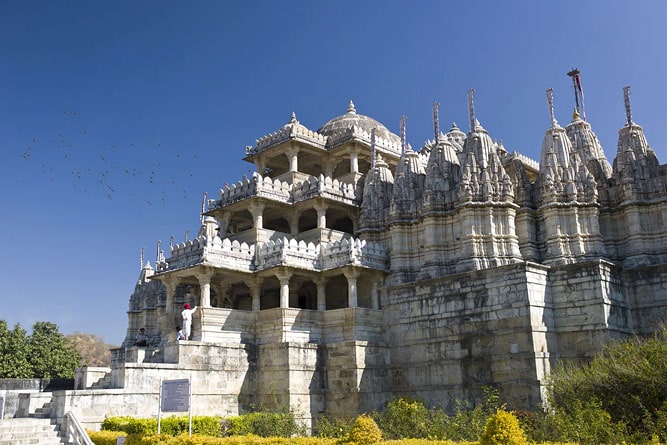
Entry fee and timings
There is no entrance charge to the temples. The temple is open every day from 12:00 pm to 6:00 pm for tourists. The temple is open from 6:00 am to 6:00 pm for the Jain community.
Facts and tips about the Dilwara Temples
- Folktales mention that artisans were paid in terms of dust they produced as an outcome of the carving stones. The more the dust indicated the more detailed the engravings were on the stones.
- It is noteworthy how labourers transported big blocks of marble up to the hilltop with only the help of elephants carrying the weights from Arasuri hills, Ambaji to Mount Abu. With no advantage of modern technologies, the labourers diligently completed the masterpiece.
- Following the Jain culture, there are no shops outside the temple selling flowers or any religious products for prayer offerings by the visitors. The authorities do not allow sitting inside the temples. The premises are not wheelchair friendly, so it is difficult to navigate them.
How to reach the Dilwara Temples
The Dilwara Temples are easily reached from Nakki Lake in less than 10 minutes by car.
See location on Google Maps
Other attractions near the Dilwara Temples
- Nakki Lake - 3.0 km
FAQs about the Dilwara Temples
1. Is anything restricted inside the temple?
The temple follows a traditional decorum that requests the visitors to not use their mobiles or cameras. You can keep it with the management at a charge of ₹50. Any leather items are not allowed inside the premises and like all other Jain temples, women during their menstruation days are asked not to step inside the temples.
2. Is there any dress code to follow while visiting the Dilwara Temples?
Yes, any revealing clothes like short trousers or anything above the knees are prohibited. They also keep long trousers that they offer at the entrance to anyone who seems to be a misfit to the dress code. So it is advised to wear full-length attire.
3. What is the timing for morning prayers?
The morning prayers are from 7:00 am to 11:00 am. Please remember, the prayer timing is only for the Jain community. Tourists are not allowed inside the temple before noon.
4. Do we need to hire local guides for the tour of the temple?
No, guides are not necessary. The local priests can guide you during the tour if you request them and at the end of the tour they expect some tips for their efforts; however, they do not pester you for money. It would be polite to pay them.
